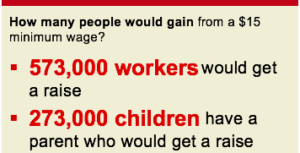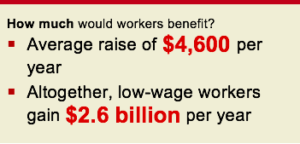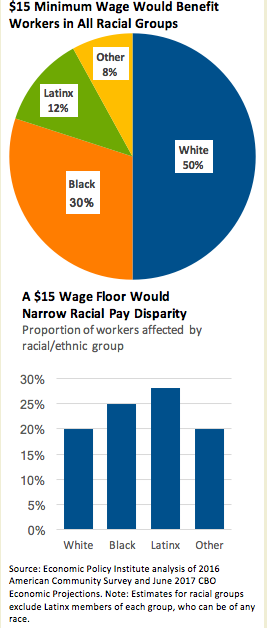What a $15 Minimum Wage Would Mean for Maryland
Good Jobs, Secure Families, and a Healthy Economy
Maryland’s economy looks great on paper.  We have a highly educated workforce, the highest median income in the country, and more millionaires per capita than any other state. At the same time, a small number of wealthy households have captured a rising share of our state’s economic growth in recent decades, leaving less for the rest of us. Since 1979, the top 1 percent of Maryland households have seen their incomes more than double (after adjusting for inflation), while wages for a typical worker increased by only 13 percent—equivalent to a 0.3
We have a highly educated workforce, the highest median income in the country, and more millionaires per capita than any other state. At the same time, a small number of wealthy households have captured a rising share of our state’s economic growth in recent decades, leaving less for the rest of us. Since 1979, the top 1 percent of Maryland households have seen their incomes more than double (after adjusting for inflation), while wages for a typical worker increased by only 13 percent—equivalent to a 0.3  percent annual growth rate.[i] In short, Maryland’s economy today delivers enormous rewards to a few while leaving many more behind.
percent annual growth rate.[i] In short, Maryland’s economy today delivers enormous rewards to a few while leaving many more behind.
While many families have been treading water, the cost of necessities like housing, child care, and health care have continued to rise. In fact, there is nowhere in Maryland where even a single adult working full time can get by on less than $15 per hour.[ii] Those working to support a family on low wages have even more difficulty making ends meet. It is little surprise that 125,000 working people across our state have family incomes below the federal poverty line ($12,140 for a single adult, or $25,100 for a family of four).[iii]
It doesn’t have to be this way. Increasing Maryland’s minimum wage to $15 per hour by 2023 (equivalent to $13.18 in today’s dollars)[iv] would make a significant difference—especially if we at the same time make tipped workers equal under the law and guarantee that our wage floor keeps up with future inflation. A family-sustaining minimum wage would build greater economic security for hundreds of thousands of Maryland workers and their loved ones, as well as boost businesses across our state through increased spending.
Here’s what a $15 wage floor would mean for Maryland:[v] 
- 573,000 workers would get a raise, totaling $2.6 billion per year, by the time the minimum wage is fully phased in in 2023.
- 273,000 children would benefit from higher family income.
- 90 percent of affected workers are at least 20 years old, and three out of five work full time.
- Workers benefiting include one in four Maryland working women, one in four Maryland workers of color, and 23,000 veterans.
Secure Families and a Healthy Economy
When families earn enough to afford the basics, the benefits ripple out to nearly every part of their lives and the broader economy.
- Research shows that when families take home higher incomes, they are better able to put food on the table and afford necessities like children’s clothing.[vi]
- When family income increases, children do better on standardized tests and finish more years of school.[vii]
- The American Public Health Association calls for a higher wage floor, citing benefits like improved infant health.[viii]
- Higher wages for low-wage workers create economic activity as families buy food and clothing or pay bills. Credible research finds little relationship between the minimum wage and the number of jobs available.[ix]
Guaranteeing all Marylanders fair pay for their work would be move us closer to an economy that works for everyone, not just those at the top.
Read the full report
[i] Economic Policy Institute analysis of Current Population Survey data and Estelle Sommeiller, Mark Price, and Ellis Wazeter, “Income inequality in the U.S. by state, metropolitan area, and county,” 2016.
[ii] Economic Policy Institute 2018 Family Budget Calculator (forthcoming). http://epi.org/resources/budget
[iii] 2016 American Community Survey one-year estimates.
[iv] Adjusted for inflation based on June 2017 Congressional Budget Office Economic Projections, https://www.cbo.gov/about/products/budget-economic-data
[v] Unpublished Economic Policy Institute analysis of 2016 American Community Survey microdata and the June 2017 CBO Economic Projections. For detailed methodology of a comparable analysis, see David Cooper, “Raising the Minimum Wage to $15 by 2024 Would Lift Wages for 41 Million American Workers,” Economic Policy Institute, April 2017, http://www.epi.org/publication/15-by-2024-would-lift-wages-for-41-million/. All estimates apply to a fully phased-in minimum wage in 2023 and are in 2017 dollars.
[vi] Kerris Cooper and Kitty Stewart, “Does Money Affect Children’s Outcomes? A Systematic Review,” Joseph Rowntree Foundation, October 2013, https://www.jrf.org.uk/sites/default/files/jrf/migrated/files/money-children-outcomes-full.pdf
[vii] Ibid.
[viii] “Improving Health by Increasing the Minimum Wage,” American Public Health Association, November 2016, https://www.apha.org/policies-and-advocacy/public-health-policy-statements/policy-database/2017/01/18/improving-health-by-increasing-minimum-wage
[ix] Doruk Cengiz, Arindrajit Dube, Attila Lindner, and Ben Zipperer, “The Effect of Minimum Wages on Low-Wage Jobs: Evidence from the United States Using a Bunching Estimator,” presented at the 2018 annual meeting of the American Economic Association, https://www.aeaweb.org/conference/2018/preliminary/paper/DSbE66Rs
